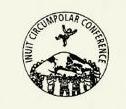Inuit Circumpolar Council facts for kids
|
Inuit Circumpolar Council
Inuit Issittormiut Siunnersuisooqatigiiffiat (Greenlandic)
Conférence circumpolaire inuite (French) Инуитский Приполярный Совет (Russian) ᐃᓄᐃᑦ ᐅᑭᐅᖅᑕᖅᑐᒥᐅᖃᑎᒌᑦ ᑲᑎᒪᔨᖏᑦ (Inuktitut) |
|

The logo of the Inuit Circumpolar Council
Stylised motif of a frame drum with a handle and a stick |
|

Member states and regions of the Inuit Circumpolar Council.
|
|
| Abbreviation | ICC |
|---|---|
| Formation | June 1980 |
| Founded at | Nuuk, Greenland |
| Type | Inter- and multinational non-governmental organization (NGO) |
| Legal status | active |
| Purpose | To promote and to ensure rights, interests, and the development of Inuit culture and languages. |
| Headquarters | Anchorage, Alaska Ottawa, Canada Nuuk, Greenland Anadyr, Russia |
|
Region served
|
4 regions
Alaska
Canada Greenland Russia |
|
Membership
|
180,000 |
|
Official languages
|
English, French |
|
Chair of the Inuit Circumpolar Council
|
Sara Olsvig |
|
Vice-Chairs of the Inuit Circumpolar Council
|
President of ICC Alaska Marie Greene President of ICC Canada Lisa Qiluqqi Koperqualuk President of ICC Greenland Kuupik V. Kleist President of ICC Russia Irina Mishina |
|
Main organ
|
ICC International |
The Inuit Circumpolar Council (ICC) is a special group that works for the Inuit and Yupik people. It's like a big team that helps about 180,000 people living in the Arctic regions of Alaska (United States), Canada, Greenland (part of Denmark), and the Chukchi Peninsula in Russia.
The ICC is a non-governmental organization (NGO). This means it's not run by a government, but by people who want to make a difference. It helps protect the rights and interests of Inuit and Yupik people. It also works to keep their unique cultures and languages strong.
The idea for the ICC started in June 1977 in Barrow, Alaska. At first, it represented Native Peoples from Canada, Alaska, and Greenland. In 1980, the group officially formed and adopted its rules. They decided to use the term "Inuit" instead of "Eskimo" for the group.
The main goals of the ICC are to connect Arctic communities and to stand up for their human, cultural, political, and environmental rights on a global scale. The ICC holds a big meeting called a General Assembly every four years. It is also one of the six groups representing Arctic Indigenous communities on the Arctic Council.
Who are the Inuit and Yupik?
The Inuit and Yupik people live across the Arctic. They are divided into different groups based on where they live:
- Canada: These groups include the Central Inuit in Nunavut, the Inuvialuit in the Inuvialuit Settlement Region, the Nunavimmiut in Nunavik, and the Nunatsiavummiut in Nunatsiavut.
- United States (Alaska): Here you'll find the Iñupiat, Yup'ik, and Siberian Yupik people.
- Greenland: The Greenlandic Inuit include the Kalaallit, Inughuit, and Tunumiit.
- Russia: The Siberian Yupik live on the Chukchi Peninsula.
Sometimes, people used to call all these groups "Eskimo." However, many Inuit people, especially in eastern Canada, don't like this word. The ICC uses "Inuit" to refer to everyone in their group. But it's important to know that Yupik people, both in Alaska and Russia, usually prefer to be called "Yupik." The word "Inuit" is not part of their traditional language.
How the ICC Works
The main goals of the ICC are to bring Inuit people closer together, to protect their human rights and language rights, and to help their culture grow.
The ICC has four main offices, one in each of the four regions where Inuit people live: Alaska, Canada, Greenland, and Russia. The leaders of these four offices, along with one elected member from each region, form the eight-person ICC Executive Council. This council is led by an International Chair.
Every four years, the ICC holds a General Assembly. This is a big meeting where Inuit people from all over the Arctic come together. They talk about important issues that affect their communities worldwide. They also decide what the organization will focus on for the next four years.
During the General Assembly, they choose a new International Chair from the country hosting the meeting. They also pick the members of the Executive Council. This meeting is where they create new plans and decisions for the future. The role of International Chair moves between the four Inuit nations every four years.
In 2006, the ICC also decided to change its name from "Inuit Circumpolar Conference" to "Inuit Circumpolar Council." This was done to make it clearer that they are an ongoing organization, not just a past meeting.
See also
- Arctic Council
- Saami Council
- West Nordic Council
- Arctic cooperation and politics
- United Nations Permanent Forum on Indigenous Issues
- International Day of the World's Indigenous Peoples
- Working Group on Indigenous Populations
- Indigenous and Tribal Populations Convention, 1957
- Indigenous and Tribal Peoples Convention
- Declaration on the Rights of Indigenous Peoples


